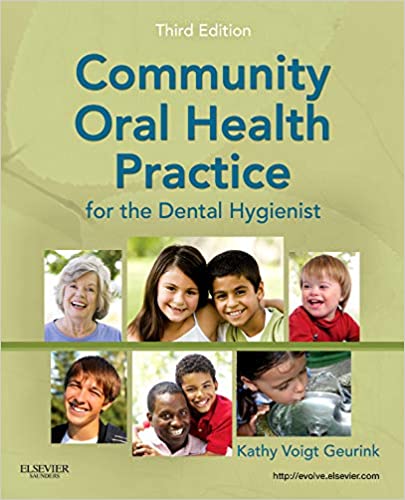Test Bank for Community Oral Health Practice for the Dental Hygienist, 3e by Kathy Voigt Geurink
$59.00 Original price was: $59.00.$28.00Current price is: $28.00.
Digital item No Waiting Time Instant Download
By: Kathy Voigt Geurink (Editor),
Robin (Con) Brocato, Linda M. Altenhoff
Publisher: Evolve
ISBN-10: 1437713513
ISBN-13: 9781437713510
Language: English
Description
Test Bank for Community Oral Health Practice for the Dental Hygienist, 3e by Kathy Voigt Geurink
Table of contents:
1. People’s Health
2. Careers in Public Health for the Dental Hygienist
3. Assessment in the Community
4. Measuring Progress in Oral Health
5. Population Oral Health
6. Oral Health Programs in the Community
7. Research
8. Health Promotion and Health Communication
9. Social Responsibility
10. Cultural Competency
11. Service-Learning
12. Planning a Student Oral Health Community Project
13. Test Taking Strategies and Community Cases
Geurink: Community Oral Health Practice for the Dental Hygienist, 3rd Edition
Chapter 01: People’s Health
Test Bank
MULTIPLE CHOICE
1. Dental public health differs from the private practice of dentistry in that it:
|
a. |
is funded by the government, but private practice is not. |
|
b. |
is the form of dental practice that serves the community as the patient rather than the individual. |
|
c. |
does not concern assessment of treatment needs as does private practice. |
|
d. |
is concerned solely with prevention rather than treatment of disease. |
ANS: B
Dental public health is the form of dental practice that serves the community as the patient rather than the individual. It is concerned with the dental education of the public, with applied dental research, and with the administration of group dental care programs, as well as prevention and control of dental diseases on a community basis.
REF: p. 2
2. Which of the following terms refers to the effort that is organized by society to protect, promote, and restore the health and quality of life of the people?
|
a. |
Class structure |
|
b. |
Population demographics |
|
c. |
Social stratification |
|
d. |
Public health |
ANS: D
Both public health and community health refer to this societal effort. Public health is concerned with lifestyle and behavior, the environment, human biology, and organizations of health programs and systems. The public pertains to the community, state, or nation. Public health is people’s health.
REF: p. 2
3. Public health problems must meet the criteria that they are a condition or situation that is a widespread actual or potential cause of morbidity or mortality and that:
|
a. |
they have been proven a valid concern by the Centers for Disease Control and Prevention (CDC). |
|
b. |
funding to treat or cure the condition is not available at the local or state level. |
|
c. |
they do not qualify for treatment as an orphan drug. |
|
d. |
there is an existing perception that the condition is a public health problem on the part of the public, the government, or public health authorities. |
ANS: D
There must be an existing perception that the condition is a public health problem. The history of public health demonstrates that after the problem has been identified and knowledge and expertise have been developed to solve the problem, the community must unify to find social and political support to proceed with the public health solutions.
REF: p. 3
4. Which of the following is a public health problem rather than public health solution?
|
a. |
Immunizations |
|
b. |
Fluoridation of drinking water |
|
c. |
Chronic diseases of the expanding population of older adults |
|
d. |
Seat belts and air bags |
ANS: C
Diseases caused by pollution of the country’s air and water systems, chronic diseases of the expanding population of older adults, inadequate funding for dental disease in indigent children, and an increase in violence among youth of today all are viewed as public health problems. Public health solutions are concerned with health promotion and disease prevention. They address the problems of the community at large.
REF: p. 3
5. Which of the following represents one of the characteristics of public health solutions?
|
a. |
A long implementation period demonstrates conscientious planning. |
|
b. |
Potency should be maintained for a short time in the event that problems require retooling. |
|
c. |
Socioeconomic status should limit distribution to those who can most easily carry the cost burden. |
|
d. |
They should be effective immediately upon application. |
ANS: D
The seven characteristics of public health solutions are as follows: not hazardous to life or function, effective in reducing or preventing the targeted disease or condition, easily and efficiently implemented, potency maintained for a substantial time period, attainable regardless of socioeconomic status, effective immediately upon application, and inexpensive and within the means of the community.
REF: p. 3
6. Which of the following dental treatment modalities meets all seven characteristics of public health solutions needed to be considered an effective treatment for dental decay?
|
a. |
Glass ionomer restorative material |
|
b. |
Stainless steel crown |
|
c. |
Community water fluoridation |
|
d. |
Dental amalgam |
ANS: C
Community water fluoridation meets all the seven characteristics to be considered an effective solution to the problem of dental decay.
REF: “p. 3, 4”
7. Community water fluoridation:
|
a. |
reaches all people, regardless of socioeconomic status. |
|
b. |
requires several years of application before positive effects can be measured. |
|
c. |
proves to be more of a financial burden than restorative treatment. |
|
d. |
only meets five of the seven characteristics considered to be an effective solution to the problem of dental decay. |
ANS: A
Community water fluoridation has proven to be a safe, cost-effective solution for reducing dental decay in children. It reaches all people regardless of socioeconomic status. It is effective immediately upon initiation and costs far less than the financial burden of restorative treatment. It meets all the seven characteristics to be considered an effective solution to the problem of dental decay.
REF: p. 3
8. About __% of adults have had tooth decay by the time they reach their early 40s.
|
a. |
50 |
|
b. |
75 |
|
c. |
90 |
|
d. |
99 |
ANS: D
About 99% of adults have had tooth decay by the time they reach their early 40s. The extent and severity of dental caries warrant the need for treatment and prevention programs throughout the United States. Dental decay, if left untreated, continues to escalate and results in expensive surgical procedures. Therefore, it is important to focus on prevention of the disease.
REF: p. 3




Be the first to review “Test Bank for Community Oral Health Practice for the Dental Hygienist, 3e by Kathy Voigt Geurink”